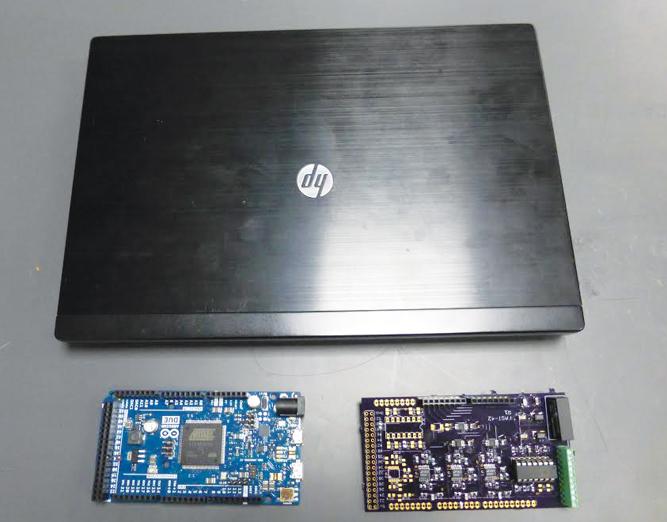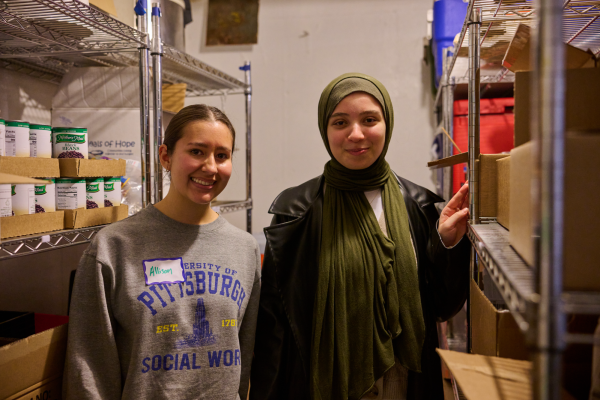Physics team builds adaptive technology
June 3, 2014
The cost of ingenuity is hard to measure. In Brian D’Urso’s case, it’s thousands of dollars in savings.
In the past year, D’Urso, an assistant professor of physics at Pitt, and his students have developed inexpensive substitutes for expensive instruments frequently used in his lab, as well as in several other undergraduate physics lab courses. “Lab-in-a-box” is one of the tentative options for the project’s name.
D’Urso is the head of the six-person Nanomaterials, Structures and Phenomena Research Group in Pitt’s physics department, a group that investigates physical properties of materials such as graphene — a one-atom-thick sheet of carbon honeycomb lattice — on the scale of one-billionth of an inch.
D’Urso’s more inexpensive materials served to supplement some of the lab material the group already had.
D’Urso said he got the idea to create more affordable lab equipment in 2011 when Everett Ramer, a technology developer in the physics department, suggested that he take a look at Arduinos — simple microcontroller boards that fit on a hand and costs about $40. Ramer suggested D’Urso incorporate them into the Analog & Digital Electronics course he was going to teach that spring.
Guided by a computer with special software running, an Arduino collects information from instruments, processes it and sends information either back to the computer or to control other instruments. Like a computer, an Arduino is not limited to any one task, but can adapt to whatever task it is programmed to do.
Last summer, D’Urso and Jocelyn Sunseri, a 2014 Pitt graduate with a degree in physics, made an Arduino behave like a “lock-in amplifier,” an instrument that picks out and amplifies the needed signal — like muting all people at a party except for the one you’re talking to. D’Urso uses the amplifier for numerous different applications in his lab.
The amplifier can be used to enhance some experiments in the lab courses as well, but D’Urso said the problem is that a new amplifier costs upward of $4,000. What D’Urso and Sunseri made cost about $90 plus the cost of the computer used to run the software.
Sunseri wrote the code for most of the software and D’Urso made a “shield” for the Arduino that cost $50. A shield is a circuit board that plugs into an Arduino and, coupled with the proper software, makes it behave like a specific off-the-shelf instrument. It’s like temporarily turning a generic robot into a cab driver or a surgeon.
D’Urso said their $90 creation can handle multiple inputs, thus behaving more like multiple off-the-shelf lock-in amplifiers. D’Urso said there are now at least a dozen Arduino-based instruments doing “a thousand different things” around his lab.
Jen-Feng Hsu, one of D’Urso’s graduate students, said he will use the $90 microcontroller boards with shields in place in an experiment for his doctoral thesis on the quantum behavior of nanomechanical oscillators, which involves subjecting a tiny crystal to electric and magnetic fields and obtaining information about it by analyzing the light it emits. D’Urso said the research is considered basic science, meaning research just for the sake of knowledge and for no particular purpose, though there are several possible applications for it.
“There is, in general, a lot of interest in this subject,” Hsu said, “But there are lots of sub-steps.”
Because the boards are able to adapt to so many different stimuli they make research more convenient. By using the homemade boards, Hsu saved thousands of dollars because he did not have to purchase multiple different instruments, but could use one board to serve multiple purposes.
Undergraduates helped bring lab-in-a-box into their lab courses.
Charles Lewandowski, a fifth-year physics and mathematics major at Pitt and the current president of Pitt’s chapter of the Society of Physics Students, worked in D’Urso’s lab last summer to work on growing the largest sheet of graphene possible. After the lock-in amplifier caught his eye, Lewandowski decided to involve the societyin the lab-in-a-box project.
D’Urso had been building the shields with his own money and SPS students volunteered their time to develop and test the Arduino-based instruments. In February, D’Urso submitted a proposal to the National Science Foundation’s “Improving Undergraduate STEM education” program to request the funding to purchase more technology and integrate it into Pitt’s physics lab courses.D’Urso has not yet received word on whether he will receive funding in the future.
D’Urso said lab-in-a-box provides a “low-cost way of making much more sophisticated instrument than would be easily affordable in the lab courses.”
But, in this case, it’s not all about the money.
“The other idea is that if you’re doing something like these instructional labs, it’s really nice if the students can totally understand everything that’s going on instead of seeing a bunch of hardware for the first time,” D’Urso said.
D’Urso said his NSF proposal also includes a more ambitious future project.
One feasible approach, he said, would be to make a website that would have all the necessary computer code plans for the circuit board and circuit descriptions “so that other people could make copies of this very easily and at a low cost.”
“The idea is that since [labs-in-a-box] are so inexpensive, there’s a possibility of high schools being able to afford these things for physics classes [and] do more sophisticated experiments with them,” D’Urso said.








